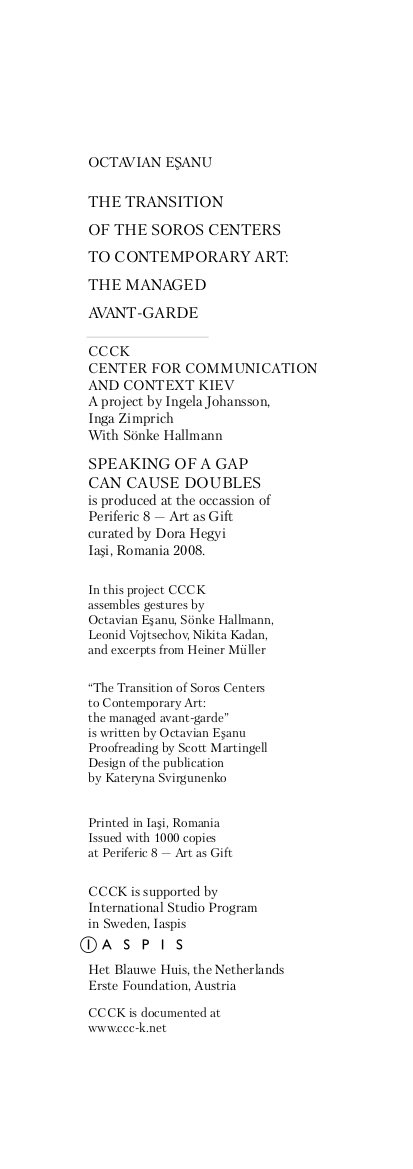Johansson, Kuznetsov, Zimprich (eds.): Post Funding Eastern Europe (2007) [English/Ukrainian]
Filed under brochure | Tags: · art system, contemporary art, eastern europe

“The Center for Communication and Context (CCCK) has been developed during a residency period in Kiev in August 2006 as a collaboration between Ingela Johansson, Volodymyr Kuznetsov and Inga Zimprich. Within the exhibition Private With Public CCCK started to investigate its host-center’s history, ideological background and future perspectives. Getting involved with a former Soros institution the idea emerged to follow other cases of Soros Centers and to investigate other East-European institutions which were established with the help of or dependant on Western cultural funding. Under the term of Post-funding we would like to expand this project during 2007, researching emerging local financial models and the interdependencies developed in cultural East-West exchange.
Since our first visit to the Center for Contemporary Art, Kiev (CCA) the local situation transformed significantly. With the appearance of the Pinschuk Art Center CCA’s exclusive role to provide a window to and from the West has changed. Given the space to shift its focus CCA is reformulating its program aiming to provide more space for experimentation, research and exhibition practices beyond the merely visual. However, the relevant decision of the Renaissance Foundation whether to support the Center in the future is still pending.” (editors)
Editors: Ingela Johansson, Volodymyr Kuznetsov, Inga Zimprich
Published by CCCK – Center for Communication and Context, Kyiv; and R.E.P. (Revolutionary Experimental Space), Kyiv
28 pages
Licensed under Creative Commons Attribution-ShareAlike 2.5 license
Octavian Eşanu: The Transition of The Soros Centers to Contemporary Art: The Managed Avant-Garde (2008)
Filed under pamphlet | Tags: · art system, contemporary art, eastern europe, institutional critique

“As in other transitological regions of the world, in Eastern Europe, throughout the 1990s, this “neo-liberal discourse of radical reform” became a new ideology. It quickly installed itself in the vacuum left after the collapse of Marxism-Leninism, and its working postulates (directed primarily at politics and economics) soon reached into the domain of art and culture, altering not only pre-established artistic and aesthetic conventions but changing also the social status of art in the post-communist society. While in such fields as politics and economy this doctrine has been recognized and accepted from the very beginning as a legitimate discourse – prompting some scholars to call for “the end of the transition paradigm” – by contrast, in art no analysis has been done on the importance of the notion of “transition” and the impact of transitology. The effect of this paradigm on art, however, was significant. Many individual changes within art resemble the pattern of political and economic reforms to such a degree that one may infer the existence of a “cultural transitology” – a hidden managerial agenda that monitored and implemented reforms in the field of culture. One of the first points on this agenda was the transition to a Western artistic model, and this was one of the main tasks of the SCCAs. One can set a parallel and compare the role of the SCCA network with that played by such active participants in the process of transition as the International Monetary Fund (IMF) and the World Bank. While these international organizations have been concerned in such fields as economics and politics with various aspects of social transformation – disputing such issues as the conversion of planned economies into free markets, or the dissemination of liberal democratic values at the expense of other political doctrines – the SCCAs dealt mainly with the emancipation of art and culture from the ideological, political and economic control of the state. On the aesthetic level this transition was manifested in the attempt to break with the doctrine of Socialist Realism, with its aesthetic and ideological principles; artists were encouraged to work with new media whereas art historians were to write new art histories, which would evolve around the narrative of the formerly suppressed non-conformism. Economically the SCCAs provided expertise for developing local networks of Western styled private and corporate art institutions capable of accommodating to the logic of the free market. After escaping the ideological and material control of the state the centers were to help local artists adjust to a new order, devoting a good part of their efforts to cultural management and fund raising.” (excerpt)
Published by CCCK, Kyiv, at Periferic 8 “Art as Gift” Biennial for Contemporary Art in Iaşi, Romania
20 pages
PDF, PDF (updated on 2019-10-22)
Comment (0)Gregory Sholette: Dark Matter: Art and Politics in the Age of Enterprise Culture (2011)
Filed under book | Tags: · art, art system, capitalism, photography, politics

“Art is big business, with some artists able to command huge sums of money for their works, while the vast majority are ignored or dismissed by critics. This book shows that these marginalised artists, the ‘dark matter’ of the art world, are essential to the survival of the mainstream and that they frequently organize in opposition to it.
Gregory Sholette, a politically engaged artist, argues that imagination and creativity in the art world originate thrive in the non-commercial sector shut off from prestigious galleries and champagne receptions. This broader creative culture feeds the mainstream with new forms and styles that can be commodified and used to sustain the few artists admitted into the elite.
This dependency, and the advent of inexpensive communication, audio and video technology, has allowed this ‘dark matter’ of the alternative art world to increasingly subvert the mainstream and intervene politically as both new and old forms of non-capitalist, public art. This book is essential for anyone interested in interventionist art, collectivism, and the political economy of the art world.”
Publisher Pluto Press, London, 2011
Marxism and Culture series
ISBN 0745327524, 9780745327525
304 pages
Reviews: Nicholas Merzoeff (Afterimage, 2011), Larne Abse Gogarty (Art Monthly, 2011), Marc James Léger (Monthly Review, 2012), Stefan Szczelkun (Mute, 2012), Dave Beech (J Modern Craft, 2012), Bruce Barber (Reviews in Culture, 2012), Molly Hankwitz (Otherzine, 2013), Theo Reeves-Evison (review31, n.d.).
PDF (updated on 2019-12-18)
Comment (0)
